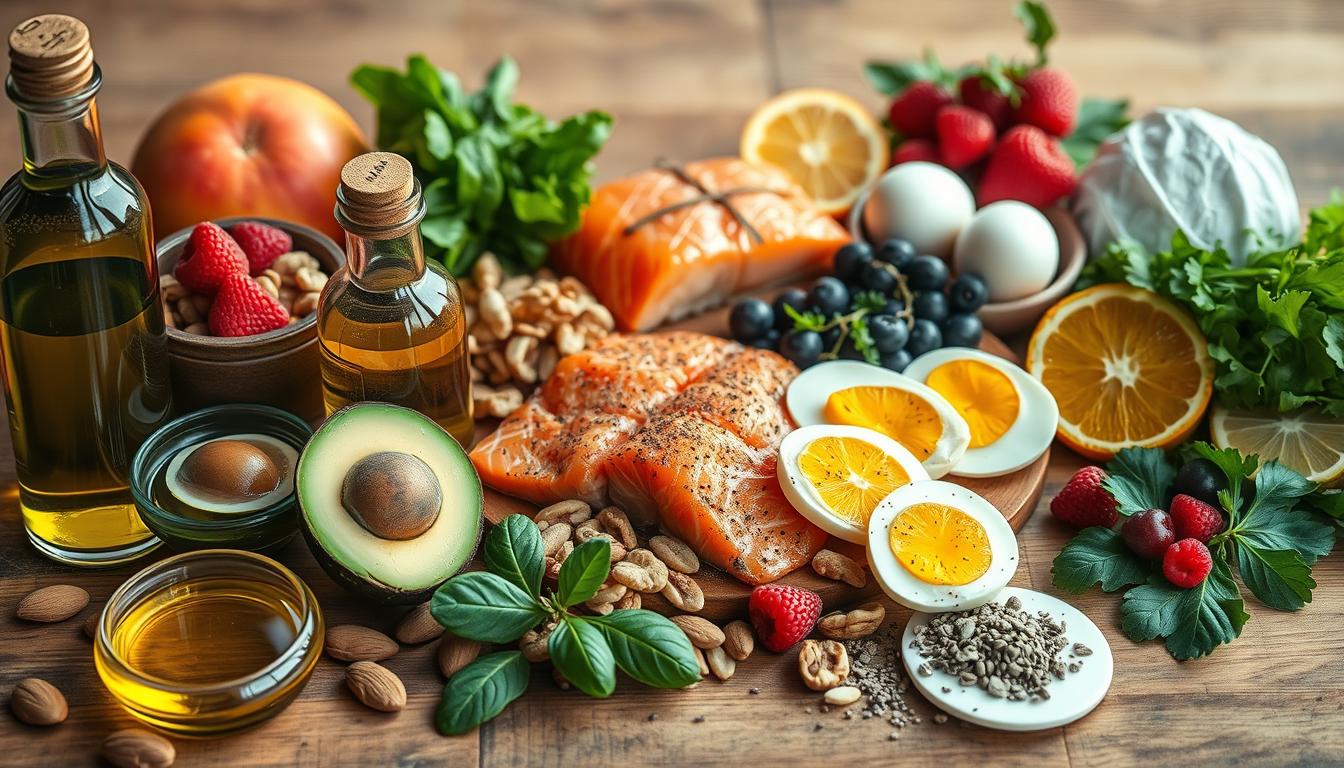Ever wonder how to fuel your body for long workouts or races? The right nutrition can make all the difference. For those who push their limits, understanding the role of fats is key to boosting performance and recovery.
Fats aren’t just energy storage—they help absorb vitamins and support low-intensity exercise. Balancing them with carbs and protein ensures you’re ready for any challenge. Let’s dive into how to optimize your diet for peak results.
Why Fat Matters for Endurance Athletes
What’s the secret to sustaining energy during extended training sessions? It’s all about how your body uses stored fuel. Fats play a crucial role in keeping you going, especially during long, low-intensity workouts. They’re not just a backup—they’re a powerhouse of energy.

The Role of Fat in Energy Storage
Fats are your body’s most efficient energy source. They store 9 calories per gram, more than double what carbs or protein provide. This makes them ideal for fueling activities that last hours. When glycogen runs low, your body taps into fat reserves to keep you moving.
How Fat Supports Endurance Performance
During steady-state exercise, fats are your best friend. They burn slowly, providing a steady stream of energy. This reduces the risk of glycogen depletion, which can leave you feeling drained. Fats also protect organs and help regulate hormones, keeping your body in balance.
| Macronutrient | Energy Density (kcal/g) |
|---|---|
| Fat | 9 |
| Carbohydrates | 4 |
| Protein | 4 |
For athletes, understanding this balance is key. While carbs are great for quick bursts, fats shine in endurance scenarios. They ensure you have the stamina to go the distance.
Understanding Macronutrients: Fat, Carbs, and Protein
Have you ever thought about what keeps you going during long workouts? The answer lies in the three macronutrients: fats, carbs, and protein. Each plays a unique role in fueling your body and supporting performance.
Carbs are your go-to for quick bursts of energy, while fats provide a steady source for longer efforts. Protein, on the other hand, helps repair and build muscle. Understanding how these nutrients work together is key to optimizing your diet.
Comparing Energy Density of Macronutrients
Not all macronutrients are created equal when it comes to energy. Fats pack the most punch, offering 9 calories per gram. Carbs and protein, meanwhile, provide just 4 calories per gram. This makes fats ideal for sustained activities, while carbs are better for high-intensity efforts.
| Macronutrient | Calories per Gram |
|---|---|
| Fat | 9 |
| Carbohydrate | 4 |
| Protein | 4 |
This difference in energy density explains why fats are your best friend during marathons, while carbs shine in sprints.
How Fat Oxidation Differs from Carbohydrate Oxidation
When it comes to fuel, your body processes fats and carbs differently. Carbs burn quickly, making them perfect for high-intensity activities. Fats, however, require more oxygen to break down but provide a longer-lasting energy source.
This process, known as fat oxidation, is essential for endurance. Training can improve your body’s ability to use fats as fuel, especially during low-intensity workouts. By balancing both, you can optimize your performance across all levels of intensity.
Types of Dietary Fat: Saturated vs. Unsaturated
Not all fats are created equal—here’s why it matters. When it comes to your dietary choices, understanding the difference between saturated and unsaturated fats can impact your health and performance.
Health Impacts of Saturated Fats
Saturated fats, found in animal products and coconut oil, can raise LDL cholesterol levels in your blood. High LDL is linked to an increased risk of heart disease. While they’re not entirely off-limits, moderation is key.
Benefits of Monounsaturated and Polyunsaturated Fats
On the other hand, unsaturated fats, like those in avocados and nuts, are heart-healthy. Monounsaturated fats can improve cholesterol levels, while polyunsaturated fats, including omega-3s, reduce inflammation and aid recovery. These sources of fat are essential for overall well-being.
Focus on whole-food options rather than processed ones. This simple swap can make a big difference in how you feel and perform.
Optimal Fat Sources for Endurance Athletes
Choosing the right fuel can transform your performance and recovery. Not all fats are equal, and picking the best sources ensures you’re getting the most out of your diet. Whole foods like avocados, nuts, and fatty fish are packed with essential nutrients that go beyond just energy.
Whole Food Sources of Healthy Fats
Whole foods are your best bet for quality fats. Salmon, almonds, chia seeds, and olive oil are excellent choices. These foods provide a mix of dietary fats, vitamins, and minerals that support overall health and recovery.
- Salmon: Rich in omega-3s, it reduces inflammation and aids muscle repair.
- Almonds: Packed with monounsaturated fats, they keep your heart healthy.
- Chia Seeds: A great plant-based source of omega-3s and fiber.
- Olive Oil: Perfect for cooking or drizzling, it’s loaded with antioxidants.
Why Processed Foods Are Less Ideal
Processed foods often strip away the nutrients found in whole foods. For example, chips might taste good, but they lack the vitamins and healthy fats found in nuts. Eating processed fats can also lead to gut distress during exercise, which is the last thing you want during a long workout.
Instead, focus on snacks like guacamole with veggies or a simple trail mix. These options are not only delicious but also provide the energy and nutrients your body needs to perform at its best.
Calculating Your Daily Fat Needs
Curious about how much fuel your body needs daily? Getting the right balance can make a big difference in your performance and recovery. Whether you’re training for a marathon or hitting the gym, understanding your daily requirements is key.
Using Grams per Kilogram of Body Weight
To calculate your needs, use this simple formula: multiply your weight in kilograms by 0.5 to 1.5. This range ensures you’re getting enough fuel without overdoing it. For example, a 70kg athlete would need between 35 and 105 grams per day.
| Weight (kg) | Daily Fat Needs (g) |
|---|---|
| 60 | 30-90 |
| 70 | 35-105 |
| 80 | 40-120 |
Adjusting Fat Intake Based on Training Intensity
Your needs change with your activity level. On rest days, you might reduce your intake slightly. During high-intensity phases, focus more on carbs for quick energy. Tracking apps like MyFitnessPal can help you stay on top of your macronutrient balance.
By tailoring your diet to your training, you’ll feel stronger and recover faster. Start with the formula, adjust as needed, and watch your performance soar.
Fat Intake During Different Training Phases
Ever wondered how to adjust your diet based on your workout intensity? Your body’s needs change depending on the type of exercise you’re doing. Understanding how to fuel for high-intensity and low-intensity sessions can make a big difference in your performance and recovery.
High-Intensity vs. Low-Intensity Training
High-intensity workouts, like sprints or interval sessions, rely heavily on quick energy. For these, focus on carb-rich meals before you start. Carbs provide the fast fuel your muscles need to power through intense efforts.
Low-intensity activities, such as long runs or base training, benefit from a steady energy source. Here, your body can tap into stored fuel more efficiently. This is where a higher proportion of healthy fats in your diet can shine.
Periodizing Your Fuel Plan for Peak Performance
Periodization isn’t just for workouts—it’s for your diet too. During base or endurance phases, aim for a higher proportion of healthy fats. This helps your body adapt to using stored fuel more effectively.
Before high-intensity sessions, switch to carb-focused meals. This ensures you have the quick energy needed for peak performance. Avoid chronic low-carb diets, especially if you’re a competitive athlete. They can limit your ability to perform at higher intensities.
Here’s a sample periodized meal plan to get you started:
- Base Phase: Avocado toast with eggs for breakfast, salmon with quinoa for lunch, and a trail mix snack.
- High-Intensity Phase: Oatmeal with fruit before training, a turkey sandwich for lunch, and a post-workout smoothie.
By tailoring your diet to your training, you’ll feel stronger and recover faster. It’s all about finding the right balance for your goals.
The Role of Fat in Recovery
Have you ever considered how fats help your body bounce back after a tough workout? Beyond fueling your performance, they play a critical role in repairing and rebuilding your body. Let’s explore how fats can speed up your recovery and keep you feeling strong.
How Fat Reduces Inflammation
Certain fats, like omega-3 fatty acids, are known for their anti-inflammatory properties. Studies show that omega-3s, found in foods like salmon and walnuts, can reduce muscle soreness and speed up recovery. These healthy fats help your body heal faster, so you’re ready for your next session.
On the flip side, processed oils can increase inflammation, slowing down your recovery. Focus on whole-food sources like avocados, nuts, and seeds to keep inflammation in check and support your overall health.
Fat’s Role in Muscle Repair
Fats are essential for rebuilding cell membranes after exercise. This process is crucial for repairing damaged muscle tissue and promoting growth. Omega-3s, in particular, have been linked to faster recovery in athletes, making them a must-have in your diet.
To maximize recovery, aim to consume healthy fats within 2 hours post-exercise. A meal like grilled salmon with a side of roasted veggies or a handful of walnuts can provide the nutrients your body needs to repair and rebuild.
By incorporating the right fats into your diet, you’ll not only recover faster but also feel stronger and more energized for your next workout.
Fat Oxidation and Endurance Performance
Want to know how your body burns fuel during long workouts? The key lies in fat oxidation, a process where your body uses stored energy to keep you moving. For athletes, understanding this can unlock better performance and stamina.
Training plays a big role in how efficiently your body burns fuel. Over time, your muscles adapt to use energy more effectively, especially during steady-state activities. Let’s break down how this works and how you can optimize it.
How Training Enhances Fat Burning
Regular exercise increases your body’s ability to burn fat. This happens through a process called mitochondrial biogenesis—basically, your cells produce more energy factories. The more mitochondria you have, the better your body can use stored fuel.
At 60-70% of your VO2 max, trained athletes burn fat more efficiently. This is the sweet spot for endurance activities. Over time, your body becomes a fat-burning machine, reducing reliance on quick carbs.
The Impact of Low Glycogen Training
Low glycogen training, like fasted morning runs, forces your body to tap into stored energy. This can improve your ability to use fat as fuel. However, it’s not without trade-offs. While it enhances fat oxidation, it can also limit high-intensity performance.
Here’s a sample low-glycogen workout:
- Start with a fasted morning run at a steady pace.
- Keep the intensity low to focus on fat burning.
- Follow up with a balanced meal to replenish energy.
Be cautious with this approach. Overusing low-carb strategies can leave you feeling drained and limit your ability to perform at higher intensities. Balance is key.
By understanding fat oxidation and glycogen stores, you can tailor your training for better endurance performance. Focus on steady-state activities to enhance fat burning, but don’t neglect carbs for high-intensity efforts. With the right balance, you’ll feel stronger and go farther.
Balancing Fat and Carbohydrate Intake
Have you ever thought about how your body uses different fuels during exercise? The key to peak performance lies in finding the right balance between carbs and fats. Each plays a unique role, and understanding how to use them can make a big difference in your results.
Carbs are your go-to for quick bursts of energy, especially during high-intensity efforts. Fats, on the other hand, provide a steady source of fuel for longer, low-intensity activities. Striking the right balance ensures you’re ready for any challenge.
Why Carbs Are Still Crucial for High Intensity
When it comes to sprints, hill climbs, or race finishes, carbs are your best friend. They yield 5-10% more energy per oxygen unit compared to fats, making them ideal for quick, explosive efforts. Without enough carbs, you might feel sluggish or unable to push your limits.
Low-carb diets can lead to fatigue, brain fog, and poor performance. While ketosis—a state where your body burns fat for fuel—works for some, it’s not a universal solution. Most athletes need carbs to perform at their best during high-intensity workouts.
The Risks of Overemphasizing Fat
Focusing too much on fats can limit your ability to perform at higher intensities. While fats are great for endurance, they don’t provide the quick energy needed for sprints or intervals. Over time, this imbalance can lead to decreased performance and slower recovery.
Here’s a look at how to balance carbs and fats for different workouts:
| Workout Type | Carb-Fat Ratio |
|---|---|
| Sprints/Intervals | 70% Carbs, 30% Fats |
| Steady-State Endurance | 50% Carbs, 50% Fats |
| Low-Intensity Recovery | 30% Carbs, 70% Fats |
Remember, everyone’s needs are different. Experiment with these ratios to find what works best for your body and goals.
Medium-Chain Triglycerides (MCTs) for Athletes
Looking for a quick energy boost during workouts? Medium-chain triglycerides (MCTs) might be the answer. These unique fatty acids are known for their rapid absorption and ability to provide immediate fuel. Unlike long-chain fats, MCTs skip several digestive steps, making them a go-to option for athletes.
How MCTs Differ from Other Fats
MCTs are shorter in structure compared to long-chain fats, which means they’re absorbed faster. This makes them ideal for quick energy during intense events or training sessions. While long-chain fats take time to break down, MCTs go straight to your liver, where they’re converted into energy almost instantly.
This rapid process helps you avoid the sluggish feeling that can come from heavier meals. Plus, MCTs are less likely to be stored as body fat, making them a smart choice for those managing their stores of energy.
Practical Uses and Limitations of MCTs
MCTs are versatile and easy to incorporate into your routine. Add a tablespoon of coconut oil to your pre-workout coffee for a quick energy boost. You can also find MCTs in energy gels or specialty supplements designed for athletes.
However, moderation is key. Consuming more than 30 grams per day can lead to digestive issues like diarrhea. Start with smaller amounts and gradually increase to see how your body responds.
Compared to carbs, MCTs provide a slower but steady energy source. While carbs are better for high-intensity efforts, MCTs shine during longer, low-intensity activities. Experiment with both to find the right balance for your needs.
Fat Intake and Body Composition
Have you ever questioned the idea that lighter always means better? For many athletes, the focus on weight loss can overshadow what truly matters: optimal body composition. It’s not just about the number on the scale—it’s about how your body is built to perform.
Why Weight Loss Isn’t Always the Goal
In endurance sports, the “lighter is better” myth is widespread. Cyclists, for example, often prioritize low weight over power-to-weight ratio. However, shedding too much weight can lead to muscle loss, which hurts performance. Muscle mass improves endurance efficiency by helping you maintain power over long distances.
Extreme leanness can also disrupt hormonal balance, leading to fatigue and slower recovery. Instead of chasing a lower number, focus on building a strong, resilient body that supports your goals.
Optimal Body Composition for Endurance Athletes
Every sport has its ideal body composition. Cyclists typically have lower body-fat percentages (6-15%) compared to ultrarunners (10-20%). These ranges reflect the demands of each sport. Cyclists benefit from leaner builds for speed, while ultrarunners need more energy reserves for long distances.
To track your progress accurately, consider a DEXA scan. This research-backed method provides detailed insights into your muscle, fat, and bone density. It’s a valuable tool for tailoring your diet and training to achieve your best performance.
Remember, your health and performance are more important than any number on the scale. By focusing on body composition, you’ll feel stronger, recover faster, and perform at your peak.
Common Myths About Fat and Performance
Ever questioned if fats are the enemy of your fitness goals? It’s time to set the record straight. Many myths surround the role of fats in nutrition, and believing them can hold you back from reaching your full potential. Let’s dive into the facts and debunk some common misconceptions.
Debunking the “Fat Makes You Fat” Myth
The idea that eating fats leads to weight gain is outdated. Research shows that weight gain is about calories, not the type of macronutrient. Fats and carbs both provide energy, but fats are more calorie-dense. This doesn’t mean they’re inherently bad—it’s about balance.
For example, studies highlight that fats play a key role in hormone production. Hormones like testosterone and estrogen rely on dietary fats to function properly. Cutting fats too low can disrupt these processes, affecting your performance and recovery.
Here’s a comparison of calorie sources:
| Macronutrient | Calories per Gram |
|---|---|
| Fats | 9 |
| Carbs | 4 |
| Protein | 4 |
As you can see, fats pack more energy, but they’re not the enemy. It’s about how you use them in your diet.
Why Low-Fat Diets Can Harm Performance
Low-fat diets might seem like a quick fix, but they can backfire. Fats are essential for absorbing fat-soluble vitamins like A, D, E, and K. Without enough fats, your body can’t use these nutrients effectively, leading to deficiencies.
Case studies of athletes show that those on higher-fat diets (30-35% of total calories) maintain better health and performance. They report improved energy levels, faster recovery, and fewer injuries. On the other hand, low-fat diets often lead to fatigue and poor results.
Here’s why low-fat diets fall short:
- They can disrupt hormone balance, affecting recovery and strength.
- Fat-free processed foods often replace healthy fats with sugars or additives.
- Without fats, your body struggles to absorb key nutrients.
Instead of cutting fats, focus on quality sources like avocados, nuts, and olive oil. These foods provide the energy and nutrients your body needs to thrive.
Practical Tips for Incorporating Fat into Your Diet
Ready to make fats work for your performance? Here’s how to do it right. Whether you’re training for a marathon or hitting the gym, these tips will help you fuel smarter and avoid common pitfalls.
Meal and Snack Ideas for Active Individuals
Snacking doesn’t have to be complicated. Here are 10 high-energy options to keep you fueled:
- Almond butter packets: Perfect for on-the-go energy.
- Olives: A savory, healthy choice.
- Avocado toast: Quick and nutrient-packed.
- Trail mix: A mix of nuts, seeds, and dried fruit.
- Greek yogurt with chia seeds: Creamy and satisfying.
- Dark chocolate: A sweet treat with healthy fats.
- Hummus with veggies: Crunchy and delicious.
- Coconut chips: Light and flavorful.
- Hard-boiled eggs: Portable and protein-rich.
- Cheese sticks: Easy and convenient.
For more snack ideas, check out these healthy snacks for athletes.
How to Avoid Gut Distress During Exercise
Timing is everything. Aim to consume fats at least 3 hours before workouts to give your body time to digest. Pre-workout meals should be low in fat to prevent GI issues.
Hydration also plays a key role. Drinking water helps ease digestion and keeps you feeling light during activity. For race-day events, test your meal plan during training to avoid surprises.
Here’s a sample day’s meal plan with macros:
| Meal | Macros |
|---|---|
| Breakfast: Avocado toast with eggs | Carbs: 30g, Protein: 15g, Fats: 20g |
| Snack: Trail mix | Carbs: 20g, Protein: 5g, Fats: 15g |
| Lunch: Grilled salmon with quinoa | Carbs: 40g, Protein: 30g, Fats: 25g |
| Snack: Greek yogurt with chia seeds | Carbs: 15g, Protein: 10g, Fats: 10g |
| Dinner: Stir-fry with tofu and veggies | Carbs: 35g, Protein: 20g, Fats: 15g |
By following these tips, you’ll feel stronger, recover faster, and perform at your best.
Conclusion: Mastering Fat Intake for Peak Endurance
Ready to take your performance to the next level? Balancing your nutrition is the key. Focus on whole foods and adjust your diet based on your training phases. Gradual changes work best, so listen to your body and make smart swaps.
Proper fueling isn’t just about today—it’s about long-term gains. Whether you’re hitting the gym or prepping for a race, the right approach keeps you strong and healthy. Start small, stay consistent, and watch your results improve.
Ready to put it into action? Download our customizable meal plan and take the first step toward your best self. Your journey to peak health and performance starts now!


